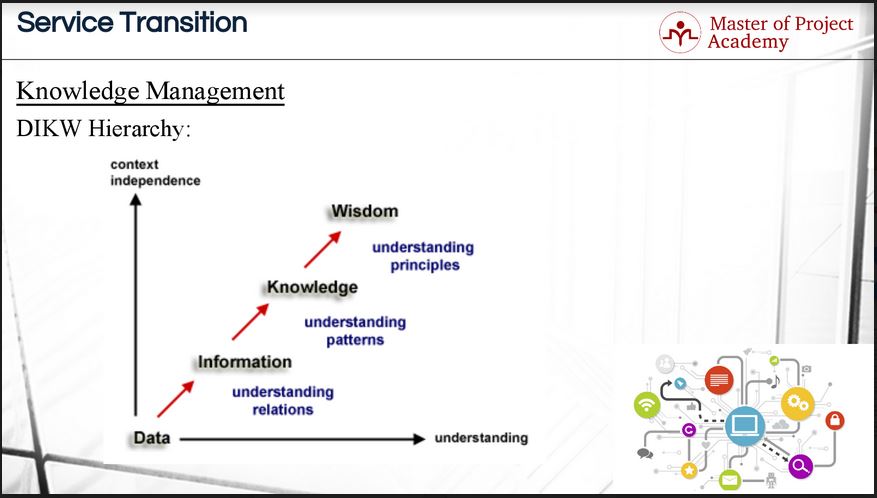The DIKW hierarchy is an example of how knowledge can be organized. It is a major step in the knowledge management process. The knowledge management process is, in turn, an essential process in the ITIL Service Transition stage of the ITIL lifecycle. ITIL foundation certification training describes the ITIL lifecycle and all its processes in detail. Any online ITIL training will provide information on the DIKW hierarchy as it is an important model for IT service managers to know and use.
Attend our 100% Online & Self-Paced Free Six Sigma Training.
What is the DIKW hierarchy and why use it?
Data is a mess and needs to be processed to make it meaningful. The DIKW hierarchy describes how data evolves into information, knowledge, and wisdom respectively. Let’s look at the definition of the DIKW hierarchy:
- D stands for Data
- I stands for Information
- K stands for Knowledge
- W stands for Wisdom
The DIKW process of transforming data into wisdom can be seen from two different angles: context and understanding. In context, one moves from a phase of gathering parts (data), the connection of parts (information), formation of a whole (knowledge) and joining of wholes (wisdom). In understanding, the DIKW hierarchy can also be seen as a process starting with researching, absorbing, doing, interacting, and reflecting. These steps connect the DIKW hierarchy in a fluid manner, no step is linked to a particular DIKW step. The DIKW hierarchy can also be regarded in terms of time. The data, information and knowledge levels are based on the past while the final step – wisdom – looks toward the future.
Data
The first step is Data. Data is the starting point for reaching a meaningful result in the end. Logging, records, measurements, etc. are all data. Since data is a mass and includes many things, there is not any interrelation at this stage; data alone does not provide meaningful results for the use of IT Service provider. Therefore data answers none of the questions to draw a conclusion. When looking at how Data is transformed into usable results using the DIKW hierarchy, we will touch on each of the subsequent steps of the of DIKW hierarchy using a sample scenario.

Information
Let’s consider that there are one million subscribers using SMS service of a telecom operator in the United States. To do capacity planning or availability planning, for example, this data itself is very broad to evaluate. Therefore, Data is processed in the Information stage of the hierarchy. Relationships in the data are revealed, and analysis is done to find an answer to Who, What, When and Where questions.
If we come back to our scenario, the following is more meaningful if 1 million SMS service users are analyzed. Eight hundred thousand users using this service are in the 15-25 age range. 80% of these users use this service from seven pm to eleven pm in the evening. And 90% of these users use SMS service when there is not internet connection on their cell phone. As you see, this analyzed data become an information and answers Who, What, When and Where questions. And this is the result of the Information step in the DIKW hierarchy.
Knowledge
The third level in the DIKW hierarchy is Knowledge. The Knowledge step aims to answer the How question. Specific measures are identified, and the information gained in the previous step is used to answer questions based on these measures. For instance, How do teenagers use SMS service? This is a How question that a company might be interested in. The information gained in the Information step can be funneled through specific measures to answer this question. This is how Information is converted into Knowledge in the DIKW hierarchy.
Wisdom
The fourth and the last step in the DIKW hierarchy is Wisdom. At the Wisdom stage, the knowledge found in the previous step is applied and implemented. Wisdom is the top level reached in DIKW hierarchy and answers the Why question. If we consider our example scenario, an example of wisdom gained might be that 95% of the SMS service users use this service for short communication when they do not wait for a response from the other party. For instance, when a user wants to say goodnight to another party, or if someone came to the meeting cafe and seeks to notify another person, etc.
As you see, starting from the usage data of the SMS service from the beginning, we processed the data in Information and Knowledge stages, and we found at the Wisdom step that most of the SMS users use this service for short communication with the other party. This is an example of how an IT service provider used the DIKW hierarchy as a model to convert data into actionable results based on wisdom.
The DIKW hierarchy
This figure represents the context of independence and understanding progress from the first step, Data, to the last step, Wisdom. As you see, Data is processed, and relationships are revealed and analyzed to reach information. As mentioned, this step answers the What, Where, When and Who questions. Then, information is processed to find understanding patterns, and this leads to accumulating knowledge and subsequently answering the How question. And finally, principles are determined and Why question is answered in the last stage of the DIKW hierarchy.

The DIKW knowledge hierarchy is but one of many ways to regard the evolution of data that is a mess, to wisdom that adds value to an IT service provider and any organization that it serves. Data alone does not tell us anything about what customers want or how they interact with brands and services. Data need to be converted from data points to information to knowledge and to wisdom to add maximum value to an organization, and this can be done using the DIKW knowledge hierarchy. Only with wisdom can an organization truly apply what they know about customers to develop new and innovative services.
Review by: Cassandra Diaz



One thought on “4 Steps Of DIKW Hierarchy: Essential Tools for Knowledge Management”
Comments are closed.